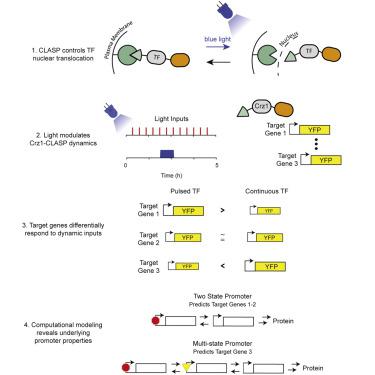Cell Systems ( IF 9.0 ) Pub Date : 2020-09-07 , DOI: 10.1016/j.cels.2020.08.009 Susan Y Chen 1 , Lindsey C Osimiri 2 , Michael Chevalier 1 , Lukasz J Bugaj 3 , Taylor H Nguyen 1 , R A Greenstein 4 , Andrew H Ng 5 , Jacob Stewart-Ornstein 6 , Lauren T Neves 1 , Hana El-Samad 7

|
Gene expression is thought to be affected not only by the concentration of transcription factors (TFs) but also the dynamics of their nuclear translocation. Testing this hypothesis requires direct control of TF dynamics. Here, we engineer CLASP, an optogenetic tool for rapid and tunable translocation of a TF of interest. Using CLASP fused to Crz1, we observe that, for the same integrated concentration of nuclear TF over time, changing input dynamics changes target gene expression: pulsatile inputs yield higher expression than continuous inputs, or vice versa, depending on the target gene. Computational modeling reveals that a dose-response saturating at low TF input can yield higher gene expression for pulsatile versus continuous input, and that multi-state promoter activation can yield the opposite behavior. Our integrated tool development and modeling approach characterize promoter responses to Crz1 nuclear translocation dynamics, extracting quantitative features that may help explain the differential expression of target genes.
中文翻译:

光遗传学控制揭示了转录因子核易位动力学的差异启动子解释。
基因表达被认为不仅受转录因子 (TF) 浓度的影响,还受其核易位动力学的影响。测试这个假设需要直接控制 TF 动力学。在这里,我们设计了 CLASP,这是一种光遗传学工具,用于快速和可调节的目标 TF 易位。使用与 Crz1 融合的 CLASP,我们观察到,对于相同的核 TF 整合浓度,随着时间的推移,改变输入动力学会改变目标基因的表达:脉动输入比连续输入产生更高的表达,反之亦然,这取决于目标基因。计算模型表明,与连续输入相比,在低 TF 输入下饱和的剂量反应可以产生更高的基因表达,并且多状态启动子激活可以产生相反的行为。











































 京公网安备 11010802027423号
京公网安备 11010802027423号